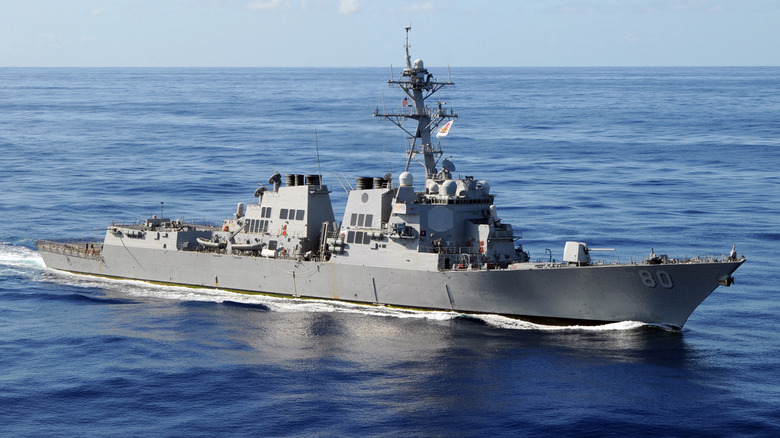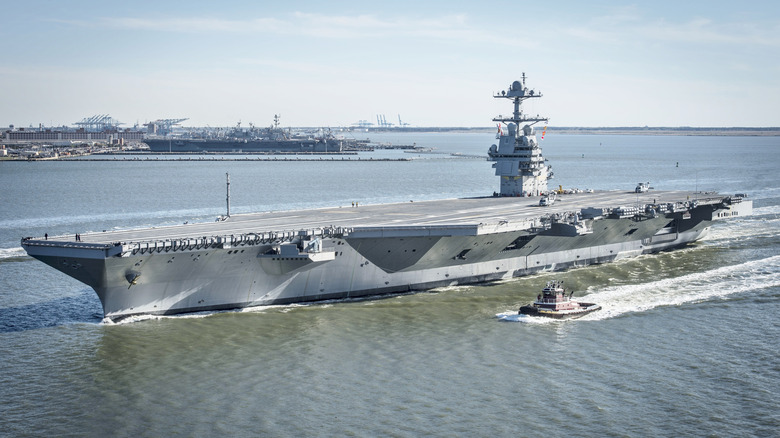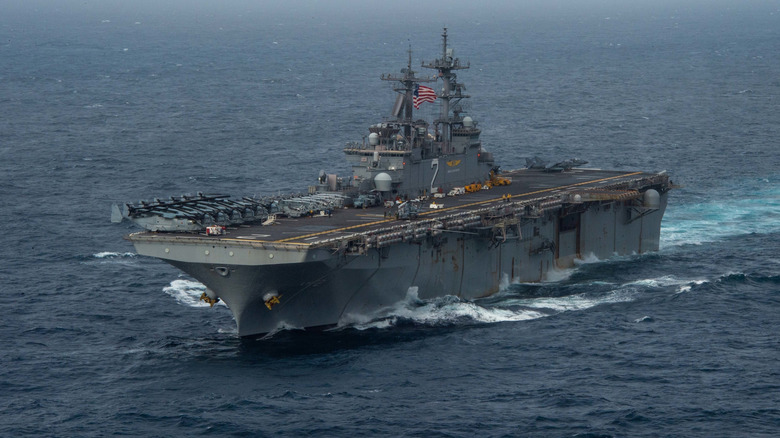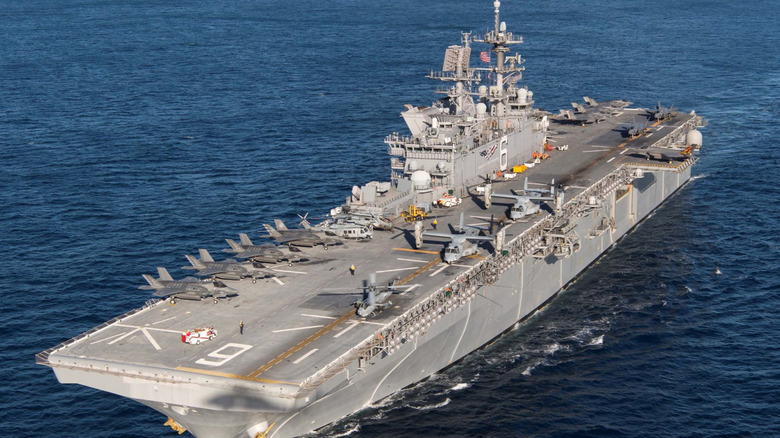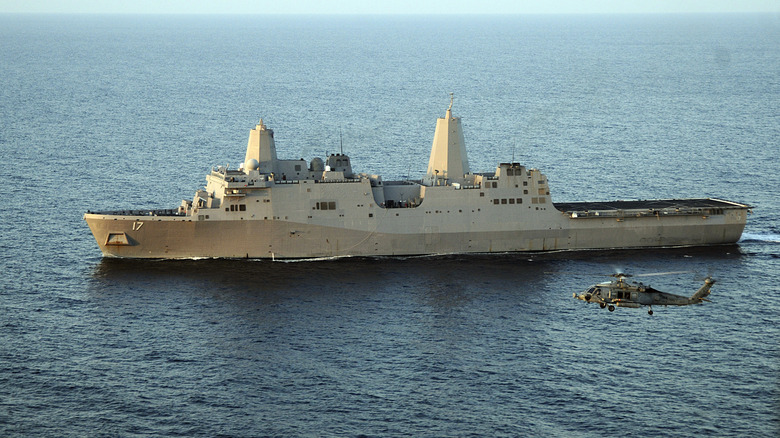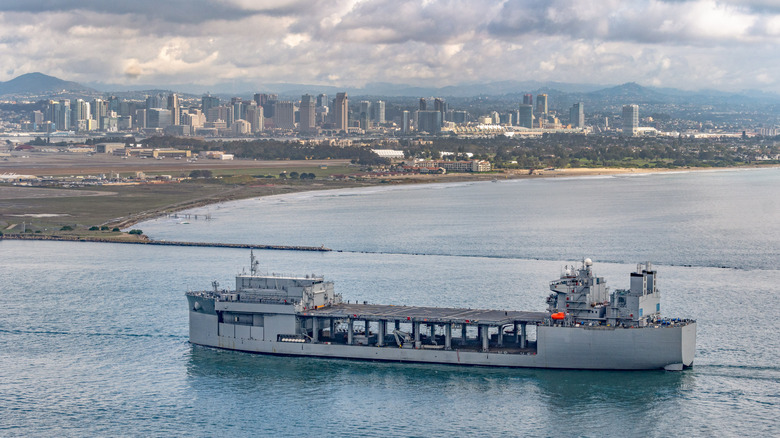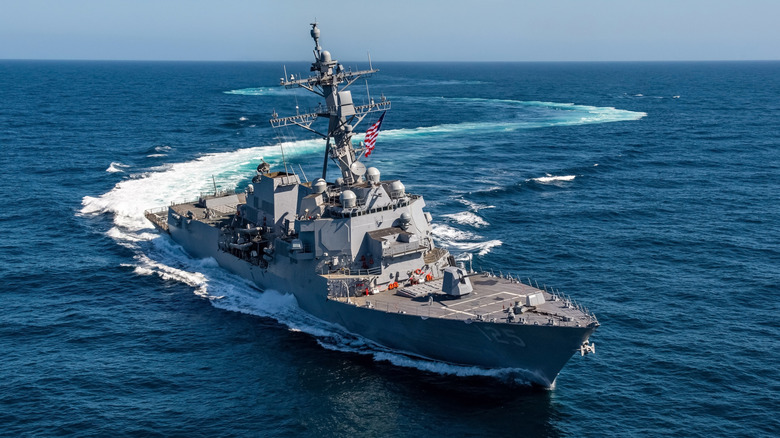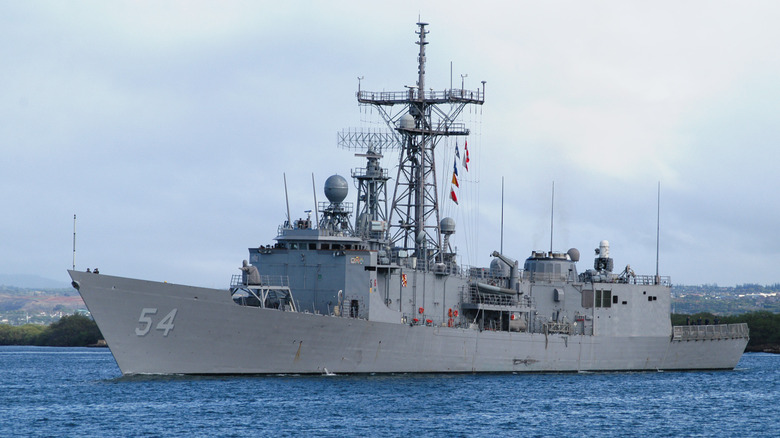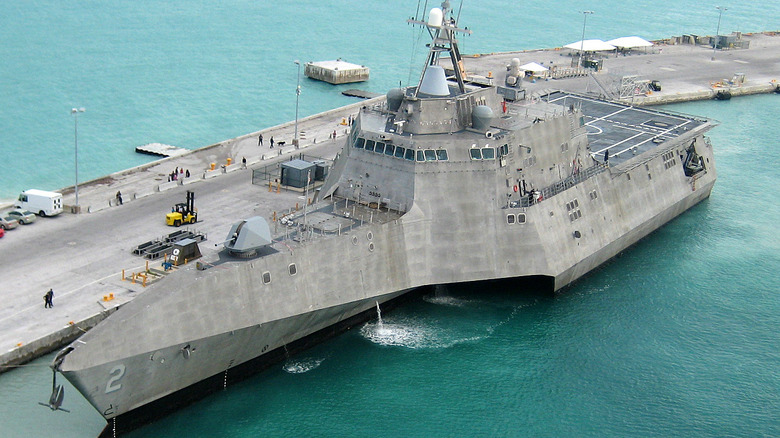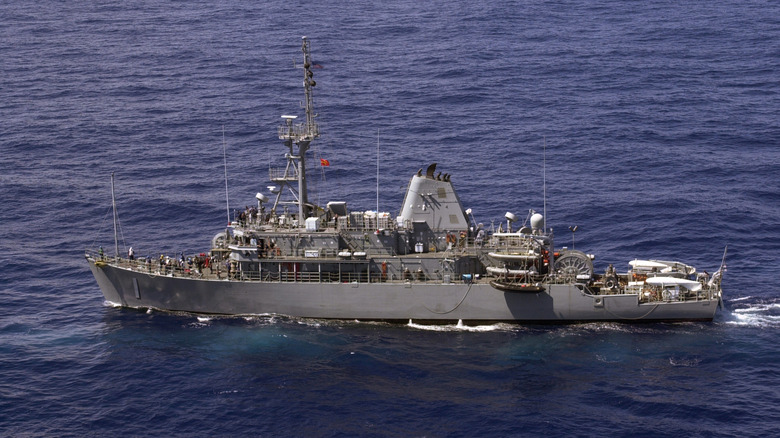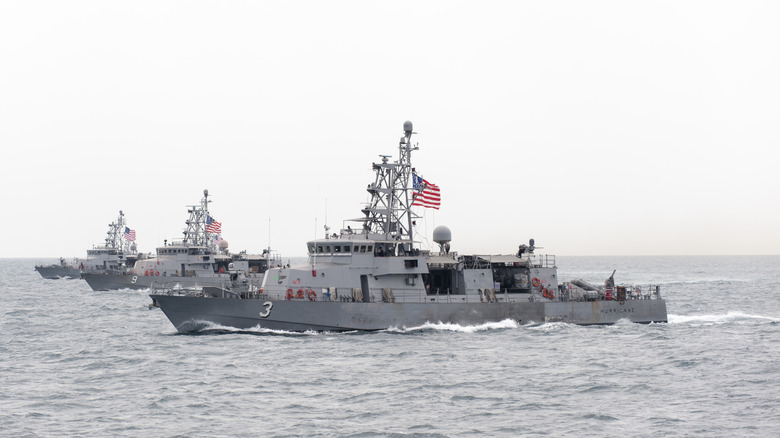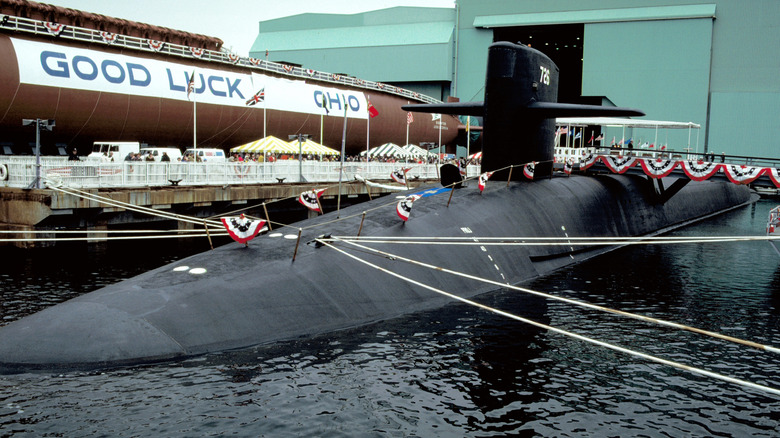14 Common Navy Ship Abbreviations (And What They Mean)
When the United States Navy ships' hull designations first appeared in 1895, ships were referred to by class followed by their series numbers, such as "Battleship 7" or "Destroyer 17," with abbreviations like "B-7" and "D-17." As the Navy grew and more classes of ships were built, a new system became necessary. In 1920, Robert E. Coontz, then Chief of Naval Operations, ordered the establishment of a standardized nomenclature. The resulting system used two-letter designations followed by the hull series number, although, as we'll see below, there are three or four-letter abbreviations, on occasion.
Under this system, some abbreviations are intuitive. "CVN," for instance, designates nuclear-powered aircraft carrier vessels. Others aren't as obvious at first glance, especially designations that include the letter "A," which can stand for auxiliary, assault, amphibious, or other concepts, depending on the role of the vessel. Plus, ships can switch abbreviations if their classifications change. One of the first ships designated under the new system, the Collier USS Langley (AC-3), was redesignated as the CV-1 when it was converted into an aircraft carrier in 1922.
Today, the Navy fields a large number of designations for vessels ranging from small landing craft to supercarriers. What follows are 14 abbreviations for some of the most important U.S. Navy ships currently sailing the world's seas. For more information about any of these ship classes, visit the Naval Vessel Register and enter an abbreviation such as "CVN" in the search box to learn about all ships that carried that designation.
CVN - Nuclear-powered Aircraft Carrier
Nuclear-powered aircraft carriers are the tip of the Navy's spear, the ships that project force to the far corners of the world. As the premier naval vessels on the planet, one might expect complete agreement about what each letter in the abbreviation "CVN" stands for. However, that isn't the case. The "C" and the "N" are easy, standing for "carrier" and "nuclear," respectively. But the "V" is a bit hazier. It could mean "heavier-than-air aircraft," "fixed-wing aircraft," or "aviation," depending on the source. The letter "A" in ship nomenclature most often designates "auxiliary," so the Navy was forced to choose a different letter to represent carrier aviation.
Regardless, aircraft carriers are extraordinary vessels, essentially mobile airfields that can respond on short notice to crises almost anywhere on Earth. They represent not just military might, but also the ability to provide disaster relief following the Indian Ocean tsunami of 2004 and other humanitarian emergencies. The world's largest aircraft carrier class is currently the Gerald R. Ford class, which weighs in at 100,000 tons and is capable of carrying up to 90 aircraft.
LHD - Landing Helicopter Dock
Landing helicopter dock ships are amphibious assault vessels designed to transport Marine Expeditionary Units (MEU) to distant battlefields. The nomenclature currently applies to Wasp-class amphibious assault ships built by Northrop Grumman Ship Systems. Each Wasp-class vessel can transport an MEU of 2,000 Marines along with helicopters and amphibious vehicles. Marines and vehicles are ferried ashore by air-cushion landing craft, which the Wasp class was purpose-designed to deploy out of its well deck, which can be flooded to allow landing craft to float in and out.
LHDs look like aircraft carriers, but the difference between a helicopter carrier and an aircraft carrier is size and mission. An LHD ship is shorter and substantially lighter than America's supercarriers, weighing in at 40,500 tons, or less than half of a Gerald R. Ford-class carrier. Plus, while a Wasp can carry fixed-wing aircraft like the AV-8B Harrier and the newer F-35B Lightning fighter, its aircraft complement consists largely of helicopters and the MV-22 Osprey tilt-rotor aircraft. Plus, where an aircraft carrier provides dominance in the sky, Wasp-class LHD ships are intended for assaulting faraway shores.
LHA - Landing Helicopter Assault
Landing Helicopter Assault (LHA) ships are also referred to as Amphibious Assault Ships. The LHA designation was originally given to Tawara-class ships and has continued to be used to designate Amphibious Assault Ships, thus resulting in the counterintuitive abbreviation. The progenitor of this class was the Iwo Jima-class Landing Platform Helicopter (LPH) ships, which could transport some 20 helicopters and 1,700 marines. Today, LHA ships include the America class, which technically are LHA(R) ships, with the "R" indicating that the America class is a replacement for the Tarawa class LHA.
LHAs resemble small aircraft carriers, just like LHD ships, and both classes perform similar missions. Indeed, the Navy's website categorizes both LHD and LHA(R) ships together on one page, explaining that both classes are "Amphibious warships [which] are designed to support the Marine Corps tenets of Operational Maneuver From the Sea (OMFTS) and Ship to Objective Maneuver (STOM)." The 44,971-ton, 844-foot America class can transport approximately 1,700 Marines and their gear, along with F-35B Lightning Joint Strike Fighters, AH-1Z Super Cobra attack helicopters, transport helicopters, and the MV-22 Osprey.
LCC - Amphibious Command Ship
The reason why Amphibious Command Ships are designated as the LCC class appears to have been lost to history, which is surprising considering the importance of these vessels to the fleet. LCC ships, such as the USS Blue Ridge and the USS Mount Whitney, were built to command amphibious operations. The Blue Ridge is the Seventh Fleet flagship, and the Mount Whitney has served as the flagship of both the Second and Sixth Fleets. Both ships were designed specifically for their command roles and can manage the 20-knot speed necessary to keep pace with the amphibious assault ships they command.
Both of these 634-foot, 18,874-ton ships were commissioned in 1971, making them among the oldest vessels serving in the U.S. Navy. Despite that, they are arguably among the most advanced ships in the fleet, as they have been retrofitted and upgraded with the latest computer and communications systems. Consequently, they are among the most advanced Command, Control, Communications, Computer, and Intelligence (C4I) warships in the world. Their large, flat decks bristle with antennas and satellite communication domes. The ships feature Kevlar armor, small landing craft, and enough space for up to 3,000 people in an emergency.
LPD - Landing Platform Dock
LPD stands for Landing Platform Dock, although the class is now generally referred to as amphibious transport docks, with the San Antonio-class ships such as the USS Philadelphia being an example. These ships are made exclusively by Ingalls Shipbuilding and are deployed along with Marine amphibious or expeditionary forces. The USS Philadelphia will be the 16th San Antonio-class LPD, with Ingalls receiving a contract in 2024 to build three more, so these ships play a major role in the Navy's amphibious strategy. They're tasked with carrying the Marines' "mobility triad," which consists of amphibious assault vehicles and landing craft air cushion (LCACs, or large hovercrafts) supported by MV-22 Ospreys.
San Antonio-class ships are 684 feet long and 105 feet wide and feature a low radar cross-section design, despite their size. They incorporate survivability features such as a shock-hardened structure and protection against fragmentation and nuclear blasts. Advanced system automation reduces crew requirements to just 361 personnel, although they can carry up to 700 Marines. Each ship can transport two LCACs, each of which can carry 60 tons of cargo, including tanks. In addition, each LPD can accommodate 14 amphibious assault vehicles and multiple helicopters of various classes, or two MV-22 Ospreys.
LSD - Dock Landing Ship
Dock landing ships transport amphibious craft and vehicles along with personnel required for amphibious assaults. The largest of these ships are LSD 41 Whidbey Island class and Harper's Ferry class vessels. The Whidbey Island-class ships were designed to transport air-cushioned landing craft (LCAC), with the capability to carry up to four LCACs along with docking and repair facilities. These ships can accommodate 340 crew members and 500 troops, while also providing helicopter landing facilities for two Sikorsky CH-53D Sea Stallion helicopters, each capable of carrying up to 38 Marines. Twelve Whidbey Island and Harper's Ferry class ships were upgraded between 1998 and 2014 to enable them to serve through 2038.
These vessels transport warriors and their equipment, but the ships are well-equipped for a fight themselves. A ship self-defense system (SSDS) protects against missiles and enemy aircraft, integrating radar, weapons control systems, and anti-air missiles to shoot down threats. The missiles are Raytheon RIM-116A Rolling Airframe Missiles (RAM), which have a range of almost six miles and which travel at Mach 2. Phalanx Mk 15 20mm close-in guns and ten machine guns provide additional protection. The ships are also fitted with Raytheon electronic warfare systems.
ESB - Expeditionary Sea Base
Expeditionary Sea Bases function as mobile special operations bases, while also performing several other duties ranging from minesweeping to refueling. A large open mission deck is visible on the side of each ship, while a flight deck enables takeoffs and landings by helicopters and tiltrotor aircraft. ESBs are built on civilian Alaska-class oil tanker hulls and measure 785 feet long with a 164-foot beam, displacing 90,000 tons. These vessels sustain speeds greater than 15 knots for up to 9,500 nautical miles, making them ideal for extended operations in distant waters.
The ships feature comprehensive facilities to support extended operations, including fuel and equipment storage, weapon magazines, mission planning and briefing rooms, communications centers, and medical facilities. There are even gyms to help crew members stay in shape on long deployments. The flight deck accommodates up to four aircraft, while two more can be stored in hangars. There are facilities to manage Airborne Mine Countermeasures (AMCM). Boats for special operations can be deployed from ESBs, including inflatables, Combat Craft Assault vessels, and unmanned surface vessels (USVs). There were six ESB ships in service by early 2024.
CG - Guided Missile Cruiser
Guided missile cruisers like the Ticonderoga class are multimission ships that can support carrier battle groups and other U.S. Navy forces, as well as serving as flagships of its surface action groups. Its mission profile includes Air Warfare, Undersea Warfare, Naval Surface Fire Support, and Surface Warfare. Their guided missile capability comes from Tomahawk cruise missiles, while all of the ship's combat capabilities are integrated by the Aegis combat management system. Some Aegis-equipped ships are also capable of ballistic missile defense.
The ability to fire Tomahawk cruise missiles gives the Navy a strike capability that confounds enemy war planning, returning surface ships to the prominence they enjoyed before the rise of air power in World War II. Tomahawk missiles have a range of 1,000 miles or more, using GPS to hit targets with pinpoint accuracy. Real-time targeting updates, terrain-following radar, and a small radar cross-section enable this weapon to hit enemies before they're aware that it's coming, making these missiles and the ships that fire them some of the most valuable naval assets in the world. Indeed, they're game changers in modern warfare.
DDG - Guided Missile Destroyer
Guided missile destroyers carry out a multi-mission role similar to guided missile cruisers. The main difference between cruisers and destroyers is size, with destroyers being smaller. Destroyers can operate independently or as part of larger groups such as carrier strike forces, but unlike cruisers, they don't command groups of their own. Today, Arleigh Burke-class destroyers play a central role in naval strategy due to their versatility.
The Arleigh Burke class destroyers replaced Charles F. Adams class destroyers and featured an innovative new hull design and propulsion systems adapted from the Spruance class destroyers. Built with all-steel construction, the class has been in continuous production since the commissioning of DDG 51 Arleigh Burke in 1991, with 73 ships delivered to the fleet and 26 more either under construction or under contract. The numbers demonstrate the centrality of the DDG class to the Navy's strategy and warfighting capability. Like guided missile cruisers, the destroyers carry Tomahawk missiles and are equipped with the Aegis system.
FFG - Guided Missile Frigate
The third member of the Navy's guided missile trio, the FFG-class guided missile frigates like the Constellation class, serve as escorts for aircraft carriers and convoys and are equipped to defend against surface ships, submarines, and small boat swarms. The Constellation class is designed to be fast and flexible, able to handle multiple types of missions in deep ocean waters or closer to shore. Construction on the USS Constellation, the first ship in its class, began in 2022. Unfortunately, the program is delayed and over budget. The weight has exceeded the original design parameters, too, threatening the vessel's speed and agility. Delivery is now expected in 2029.
When it's completed, the frigate will measure 496 feet in length with a displacement of 7,291 tons. It will feature the Aegis Combat System, as well as an Enterprise Air Surveillance Radar (EASR) and a vertical missile launch system. It will sport cutting-edge communications systems, electronic warfare capabilities, and defensive countermeasures. The FFG class's small size belies its extraordinary capabilities.
LCS - Littoral Combat Ship
The U.S. Navy's littoral combat ships have been mired in controversy due to technical issues and operational limitations. The Littoral Combat Ship (LCS) was originally designed as the Navy's solution for fighting in shallow, near-shore waters where bigger warships couldn't operate effectively. The vessels would have swappable mission modules for roles like hunting small submarines and defending against missile boats. However, the LCS-class ships have suffered from persistent mechanical problems and breakdowns that have plagued the fleet since they entered service.
To make matters worse, Congress cut funding for the mission modules that were supposed to give these ships their versatility and punch. This left the Navy with vessels that are essentially fast but lightly armed — they lack the long-range air defenses needed to protect themselves from enemy missiles and drones, and they don't have the firepower to strike back at shore-based threats. What was meant to be a flexible, multi-mission platform has instead become a ship without a clear role. The LCS's shortcomings were laid bare when the Navy chose not to send it to fight Houthi rebels along the coast of Yemen — a scenario that was almost tailor-made for the kind of ship the LCS was meant to be.
MCM - Mine Countermeasure Ship
Mine countermeasure ships perform a vital mission during warfare, detecting and destroying mines in active combat areas. For example, the Avenger class can find and destroy moored and bottom mines. These ships use cutting-edge sensors, cable cutters, and detonating devices to eliminate mines. However, the Avenger class MCM ships will be retired soon as USV (unmanned surface vessels) begin to take over the role. This remote countermining capability will be deployed on the LCS-class ships, making the Avenger obsolete.
For the time being, though, the fourteen Avenger-class ships remain in service. They're small ships, 224 feet in length and displacing 1,312 tons. The crew consists of 8 officers and 76 enlisted sailors. Top speed is 14 knots. MCM ships are bristling with anti-mine technology, including a magnetic/acoustic sweep system, mine-hunting sonar, a mechanical sweep system, and mine neutralizing equipment. Defensive armaments are limited to a pair of .50-caliber machine guns.
PC - Patrol Ship
The last patrol ship was retired from the U.S. Navy in 2023, but several former PC class ships will be transferred to foreign navies. For instance, Cyclone patrol ships have been sold to Egypt, Bahrain, and the Philippines. Most of them had been stationed in Bahrain during their active service with the U.S. Navy, since the Navy favored these small ships for patrolling the Persian Gulf. They weigh only 385 tons, but they're well-armed with stabilized 25mm guns, machine guns, and grenade launchers. In 2013, the Navy also tested firing small missiles from these vessels.
The Philippine Navy took possession of the final three PCs when they were decommissioned from the U.S. Navy in 2023. The ships joined the USS Cyclone, the original ship of the Cyclone class, which the Philippine Navy purchased in 2004. The ships will join the Philippine Navy's Littoral Combat Force, which patrols the waters of the island country on counter-insurgency missions. In total, the Philippines operates three PCs. Bahrain fields five PCs, having seen their value up close in standoffs between the Bahrain-based PCs of the U.S. Navy and Iran. The Egyptian Navy operates three of the former U.S. Navy PCs.
SSN/SSGN/SSBN - Nuclear Submarines
All ship designations beginning with SS are submarines; SSN designates attack submarines, while SSGN subs launch cruise missiles, and SSBNs launch ballistic missiles. As indicated by the "N" in their nomenclature, they are one of the categories of nuclear-powered ships that aren't aircraft carriers. Attack submarines (SSNs) and guided-missile submarines (SSGNs) are multi-mission vessels that perform various operations but do not carry nuclear weapons. SSGNs launch tactical missiles, including Tomahawks. Ohio-class SSGN subs can carry as many as 154 Tomahawks in 22 missile tubes. They can also use their communications capabilities to support Special Operations Forces.
SSBNs, on the other hand, form part of the Nuclear Triad, which is a combination of land-based missiles, nuclear bombers, and SSBNs, colloquially called Boomers. The SSBNs represent the sea-based leg of the triad, offering greater survivability due to their ability to hide beneath the waves. Of course, some of the USA's adversaries also field this capability; to counter this, SSN-class attack submarines hunt enemy subs. They also hunt surface ships, transport Special Operations Forces, carry out reconnaissance missions, support battle groups, and more.
